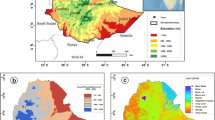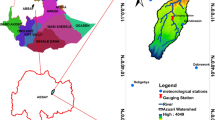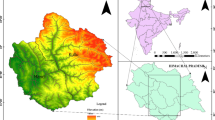Abstract
Lake Tuz is a hypersaline lake located on the Central Anatolia plateau. The lake is one of the most important wetlands in Turkey, due to its unique ecosystem and biota, but it has been degraded due to the loss of most of its water-covered area. This study analyzes the changes at the surface of Lake Tuz over the past 32 years and discusses the relationship between this change and climatic factors. This study was made in two parts: (1) surface changes of the lake during the period 1985–2016 were evaluated based on satellite images, and (2) the relationship between surface change and climatic factors was studied using standardized precipitation index (SPI), Palmer Drought Severity Index (PDSI), and Erinç aridity index (EAI). Even though standardized spring precipitation at Lake Tuz Basin have not revealed any statistically significant long-term trend during the study period, it tended to decrease apparently during a long period from the year 2001 to 2013. This drought period was also evident in the series of 12-month PDSI during the 2002–2009 periods along with the years of 2012 and 2013. It is detected a statistically significant negative relationship between the salt-covered areas and EAI (r = − 0.63) in the long term (1985–2016). For the first period prior to the 2000s, the relationship between EAI and the salt-covered area was weaker (r = − 0.46), mostly because the lake was not significantly affected by the lack of precipitation yet due to the sufficient groundwater level. Since about 2000, groundwater withdrawals, rising temperatures, and severe and more frequent droughts strengthened the relationship between the lake’s salt-covered area and EAI (r = − 0.88). Precipitation records of Lake Tuz Basin showed a significant negative relationship with the indices of North Atlantic Oscillation (NAO), Arctic Oscillation (AO), and winter North Sea Caspian Pattern during the study period. The persistence of NAO and AO indices in a positive phase over the last 20 years has partly explained the decrease in the water-covered area observed in the lake.








Similar content being viewed by others
References
Aghamohamadnia M, Abedini A (2014) A morphology-stitching method to improve Landsat SLC-off images with stripes. Geod Geodyn 112:3112–3130. https://doi.org/10.1016/j.rse.2008.03.009
Arai K, Bu X (2007) ISODATA clustering with parameter (threshold for merge and split) estimation based on GA: genetic algorithm. Rep Fac Sci Engrg Saga Univ 36:17–23
Arslan V, Göçmez G (2007) Tuz Gölü havzasında yeraltı suyunun yok oluşu (Eşmekaya-Sultan Hanı örneği) (In Turkish). J Fac Eng Arch Selcuk Univ 23:1–2
Barrett DC, Frazier AE (2016) Automated method for monitoring water quality using Landsat imagery. Water 8:257. https://doi.org/10.3390/w8060257
Baumann PR (2010) Remote sensing: Landsat program. http://employees.oneonta.edu/baumanpr/geosat2/RS%20Landsat/RS-Landsat.htm. Accessed 20 May 2017
Berkeley (2003) http://gif.berkeley.edu/documents/Landsat%20Band%20Information.pdf. Accessed 12 April 2017
Biazin B, Sterk G (2013) Drought vulnerability drives land-use and land cover changes in the Rift Valley dry lands of Ethiopia. Agric Ecosyst Environ 164:100–113. https://doi.org/10.1016/j.agee.2012.09.012
Birbir M, Sesal C (2003) Extremely halophilic bacterial communities in Şereflikoçhisar Salt Lake in Turkey. Turk J Bıol 27:7–22
Birkett CM (1995) The contribution of TOPEX/POSEIDON to the global monitoring of climatically sensitive lakes. J Geophys Res Oceans 100:25179–25204. https://doi.org/10.1029/95JC02125
Burns NM, Rutherford JC, Clayton JS (1999) A monitoring and classification system for New Zealand lakes and reservoirs. Lake Reservoir Manag 15:255–271. https://doi.org/10.1080/07438149909354122
Chawira M, Dube T, Gumindoga W (2013) Remote sensing based water quality monitoring in Chivero and Manyame lakes of Zimbabwe. Phys Chem Earth 66:38–44. https://doi.org/10.1016/j.pce.2013.09.003
Chen F, Zhao X, Ye H (2012) Making use of the Landsat 7 SLC-off ETM+ image through different recovering approaches. In: Karakehayov Z (ed) Data Acquisition Applications. InTech, Croatia, pp 317–342
Clark Labs (1987) https://clarklabs.org/terrset/
Dengiz O, Baskan O (2009) Land quality assessment and sustainable land use in Salt Lake (Tuz Gölü) specially protected area. Environ Monit Assess 148:233–243. https://doi.org/10.1007/s10661-008-0154-4
Dengiz O, Ozcan H, Köksal ES, Baskan O, Kosker Y (2010) Sustainable natural resource management and environmental assessment in the Salt Lake (Tuz Gölü) specially protected area. Environ Monit Assess 161:327–342. https://doi.org/10.1007/s10661-009-0749-4
Diffenbaugh NS, Swain DL, Touma D (2015) Anthropogenic warming has increased drought risk in California. PNAS 112(13):3931–3936. https://doi.org/10.1073/pnas.1422385112
Doğdu MŞ, Toklu MM, Sağnak C (2007) Konya Kapalı Havzası’nda yağış ve yeraltı suyu seviye değerlerinin irdelenmesi (In Turkish). I. Türkiye İklim Değişikliği Kongresi–TİKDEK 2007. 11–13 Nisan 2007. İstanbul
Environmental Systems Research Institute (ESRI) (1969) https://www.esri.com/en-us/home. Accessed 20 February 2017
Erinç S (1965) An attempt on precipitation efficiency and a new index (in Turkish). İstanbul Üniversitesi Coğrafya Enstitüsü Yayınları, no. 41, İstanbul
Erol A, Randhir TO (2012) Climatic change impacts on the ecohydrology of Mediterranean watersheds. Clim Chang 114:319–341. https://doi.org/10.1007/s10584-012-0406-8
Giardino C, Oggioni A, Bresciani M, Yan H (2010) Remote sensing of suspended particulate matter in Himalayan lakes. Mt Res Dev 30:157–168. https://doi.org/10.1659/MRD-JOURNAL-D-09-00042.1
Global Surface Water Explorer (2019) https://global-surface-water.appspot.com/. Accessed 18 December 2019
Göçmez G, İşçioğlu A (2004) Konya Kapalı Havzası’nda Yeraltı Suyu Seviye Değişimleri (In Turkish). Yeraltı suyunun Kullanımı, Problemler ve Çözüm Yolları. 22–24 Aralık. Konya, Turkey, pp 9–18
Gürol S, Özen H, Leloğlu UM, Tunalı E (2008) Lake Tuz: new absolute radiometric calibration test site. In: XXIst ISPRS Congress, pp 3–11 July 2008, Beijing, China
Gürol S, Behnert I, Özen H, Deadman A, Fox N, Leloğlu UM (2010) Lake Tuz: new CEOS reference standard test site for infrared visible optical sensors. Can J Remote Sens 36:553–565. https://doi.org/10.5589/m10-086
Humboldt State University (2015) http://gsp.humboldt.edu/olm_2015/Courses/GSP_216_Online/lesson4-1/radiometric.html. Accessed 20 October 2017
Jones PD, Jónsson T, Wheeler D (1997) Extension to the North Atlantic oscillation using early instrumental pressure observations from Gibraltar and south-West Iceland. Int J Climatol 17:1433–1450. https://doi.org/10.1002/(SICI)1097-0088(19971115)17:13<1433::AID-JOC203>3.0.CO;2-P
Kaufman YJ, Sendra C (1988) Algorithm for automatic atmospheric corrections to visible and near-IR satellite imagery. Int J Remote Sens 9:1357–1381. https://doi.org/10.1080/01431168808954942
Khazaei B, Khatami S, Alemohammad SH, Rashidi L, Wu C, Madani K, Kalantari Z, Destouni G, Aghakouchak A (2019) Climatic or regionally induced by humans? Tracing hydro-climatic and land-use changes to better understand the Lake Urmia tragedy. J Hydrol 569:203–217. https://doi.org/10.1016/j.jhydrol.2018.12.004
Kılıç O, Kılıç AM (2010) Salt crust mineralogy and geochemical evolution of the Salt Lake (Lake Tuz), Turkey. Scı Res Essays 5(11):1317–1324
Köylü M (2017) Salt Lake’s financial investment value and its contribution to economic growth (in Turkish with English abstract). International Journal of academic value studies 3(15):127–137. https://doi.org/10.23929/javs.554
Koyuncu Salt (2020) https://www.koyuncutuz.com/en/kurumsal-hakkimizda_5. Accessed 06 April 2020
Kutiel H, Türkeş M (2005) New evidence for the role of the North Sea – Caspian pattern on the temperature and precipitation regimes in continental Central Turkey. Geogr Ann A 87:501–513. https://doi.org/10.1111/j.0435-3676.2005.00274.x
Kutiel H, Maheras P, Türkeş M, Paz S (2002) North Sea - Caspian pattern (NCP) – an upper level atmospheric teleconnection affecting the eastern Mediterranean – implications on the regional climate. Theor Appl Climatol 72:173–192. https://doi.org/10.1007/s00704-002-0674-8
Lillesand TM, Kiefer RW, Chipman JW (2004) Remote sensing and image interpretation. Fifth Edition. John Wiley & Sons, U.S.A
McCullough IM, Loftin CS, Sader SA (2012) High-frequency remote monitoring of large lakes with MODIS 500 m imagery. Remote Sens Environ 124:234–241. https://doi.org/10.1016/j.rse.2012.05.018
Ministry of Culture and Tourism (MCT) (2013) http://www.kulturvarliklari.gov.tr/TR-51375/tuz-golu-ozel-cevre-koruma-alani.html. Accessed 13 May 2019
National Weather Service-Climate Prediction Center (NWS-CPC) (2005) The standardized 3-month running mean value of the AO index. https://www.cpc.ncep.noaa.gov/products/precip/CWlink/daily_ao_index/month_ao_index.shtml. Accessed 12 December 2018
Orhan O, Ekercin S, Dadaser-Çelik F (2014) Use of Landsat land surface temperature and vegetation ındices for monitoring drought in the Salt Lake Basin area, Turkey. Sci. World J 14:29–39. https://doi.org/10.1155/2014/142939
Ormeci C, Ekercin S (2007) An assessment of water reserve changes in Salt Lake, Turkey, through multi-temporal Landsat imagery and real-time ground surveys. Hydrol Process 21:1424–1435. https://doi.org/10.1002/hyp.6355
Öztürk T, Ceber ZP, Türkeş M¸ Kurnaz ML (2015) Projections of climate change in the Mediterranean Basin by using downscalped global climate model outputs. Int J Climatol 35:4276–4429. doi: https://doi.org/10.1002/joc.4285
Palmer WC (1965) Meteorological drought. Research paper. No. 45. Office of Climatology U.S. weather bureau, Washington
Pekel J-F, Cottam A, Gorelick N, Belward AS (2016) High-resolution mapping of global surface water and its long-term changes. Nature 540:418–422. https://doi.org/10.1038/nature20584
QGIS (2002) https://qgis.org/tr/site.
Rahman (2015) http://fght.utm.my/nurulhazrina/files/2015/05/L12-Unsupervised-classification.pdf. Accessed 9 February 2017
Raveh-Rubin S, Wernli H (2015) Large-scale wind and precipitation extremes in the Mediterranean: a climatological analysis for 1979-2012. Q J R Meteorol Soc 141(691):2404–2417. https://doi.org/10.1002/qj.2531
Roy DP, Ju J, Lewis P, Schaaf C, Gao F, Hansen M, Lindquist E (2008) Multi-temporal MODIS-Landsat data fusion for relative radiometric normalization, gap filling, and prediction of Landsat data. Remote Sens Environ 112:3112–3130. https://doi.org/10.1016/j.rse.2008.03.009
Scaramuzza P, Micijevic E, Chander G (2004) SLC gap-filled products phase one methodology. Landsat Technical Notes, USGS
Sheng Y, Song C, Wang J, Lyons EA, Knox BR, Cox JS, Gao F (2016) Representative lake water extent mapping at continental scales using multi-temporal Landsat-8 imagery. Remote Sens Environ 185:129–141. https://doi.org/10.1016/j.rse.2015.12.041
Special Environmental Protection Agency (SEPA) (2001) Integrated feasibility study sanitation Tuz Lake. Technical Report, Ankara, Turkey
Sumer V (2012) KOP Bölgesi ve Su İhtiyacı: Su Temin Alternatiflerine Genel Bir Bakış (In Turkish). http://www.kop.gov.tr/upload/dokumanlar/46.pdf. Accessed 24 December 2019
Tatlı H, Türkeş M (2011) Empirical orthogonal function analysis of the Palmer drought indices. Agric For Meteorol 151:981–991. https://doi.org/10.1016/j.agrformet.2011.03.004
Thakur JK, Srivastava PK, Singh SK, Vekerdy Z (2012) Ecological monitoring of wetlands in semi-arid region of Konya closed basin, Turkey. Reg Environ Chang 12:133–144. https://doi.org/10.1007/s10113-011-0241-x
Thornthwaite CW (1948) An approach toward a rational classification of climates. Geophys Rev 38:55–94. https://doi.org/10.2307/210739
Türkeş M, Akgündüz AS (2011) Assessment of the desertification vulnerability of the Cappadocian district (Central Anatolia, Turkey) based on aridity and climate-process system. Int J Hum Sci 8:1234–1268
Türkeş M, Erlat E (2005) Climatological responses of winter precipitation in Turkey to variability of the North Atlantic Oscillation during the period 1930−2001. Theor Appl Climatol 81:45–69. https://doi.org/10.1002/joc.962
Türkeş M, Erlat E (2018) Variability and trends in record air temperature events of Turkey and their associations with atmospheric oscillations and anomalous circulation patterns. Int J Climatol 38:5182–5204. https://doi.org/10.1002/joc.5720
Türkeş M, Yozgatlıgil C, Batmaz İ, İyigün C, Koç EK, Fahmi FM, Aslan S (2016) Has the climate been changing in Turkey? Regional climate change signals based on a comparative statistical analysis of two consecutive time periods, 1950−1980 and 1981−2010. Clim Res 70:77–93. https://doi.org/10.3354/cr01410
Turunçoğlu UU, Türkeş M, Bozkurt D, Önol B, Şen ÖL, Dalfes HN (2018) Climate of Turkey. In: Akça G (ed) Kapur. Springer International Publishing, The Soils of Turkey. Springer World Soils Book Series, pp 25–44
United States Geological Survey (USGS) (2019) https://earthexplorer.usgs.gov. Accessed 27.12.2019
Üstün A, Tuşat E, Abbak RA (2007) Konya Kapalı Havzası’nda Yeraltı Suyu Çekilmesi ve Olası Sonuçlarının Jeodezik Yöntemlerle İzlenmesi (In Turkish). Selçuk Üniversitesi 3. Mühendislik Ölçmeleri Sempozyumu. Konya
Wikipedia (2020) Lake Tuz. https://en.wikipedia.org/wiki/Lake_Tuz. Accessed 06 April 2020
Woolway RL, Merchant CJ (2018) Intralake heterogeneity of thermal responses to climate change: a study of large northern hemisphere lakes. J Geophys Res-Atmos 123:3087–3098. https://doi.org/10.1002/2017JD027661
World Wildlife Fund (WWF) (2014) Konya’da Suyun Bugünü Raporu (In Turkish). http://www.wwf.org.tr/?4660. Accessed 23 December 2019
Yesuf HM, Assen M, Melesse AM, Alamirew T (2015) Detecting land use/land cover changes in the Lake Hayq (Ethiopia) drainage basin, 1957–2007. Lakes Reserv Res Manag 20:1–18. https://doi.org/10.1111/lre.12082
Yılmaz M (2010) Environmental problems caused by ground water level changes around Karapinar (Turkish with English abstract). Ankara Üniversitesi Çevrebilimleri Dergisi 2(2):145–163. https://doi.org/10.1501/Csaum_0000000033
Zhang Z, He G, Wang X (2010) A practical DOS model-based atmospheric correction algorithm. Int J Remote Sens 31(11):2837–2852. https://doi.org/10.1080/01431160903124682.ised-classification.pdf
Acknowledgments
We would like to thank the Editor and anonymous reviewers for their valuable feedback to improve the quality of this paper.
Author information
Authors and Affiliations
Corresponding author
Additional information
Communicated by Wolfgang Cramer
Publisher’s note
Springer Nature remains neutral with regard to jurisdictional claims in published maps and institutional affiliations.
Rights and permissions
About this article
Cite this article
Aydin, F., Erlat, E. & Türkeş, M. Impact of climate variability on the surface of Lake Tuz (Turkey), 1985–2016. Reg Environ Change 20, 68 (2020). https://doi.org/10.1007/s10113-020-01656-z
Received:
Accepted:
Published:
DOI: https://doi.org/10.1007/s10113-020-01656-z




